 Area of a Triangle
Area of a Triangle
An earlier section, Area Formulas: Triangle, Parallelogram, Trapezoid, showed how to find the area of a triangle with a base/height pair. The key results are summarized here for convenience.
With trigonometry now in hand, another useful formula for the area of a triangle is given.
- Area of a Triangle using a Base/Height Pair
- Area of a Triangle using Two Sides and an Included Angle
Area of a Triangle Using a Base/Height Pair
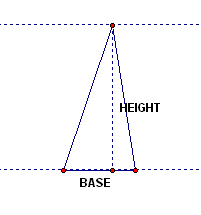
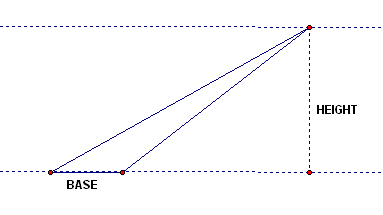
Take a vertex of a triangle. Drop a perpendicular to the opposite side or (if needed) to an extension of the opposite side.
The segment just created is called a height or altitude of the triangle. The side opposite the vertex is called the corresponding base.
Since every triangle has three vertices, every triangle has three base/height pairs.
Area is half base times height:
$$ \begin{gather} \cssId{s14}{\text{Area of triangle}}\cr \cssId{s15}{\text{with base $\,b\,$ and height $\,h\,$}}\cr \cssId{s16}{= \frac 12 bh} \end{gather} $$
Drop a perpendicular to the opposite side ...

... or, to an extension of the opposite side.
Derivations of the Area of a Triangle Formula
A derivation of the triangle area formula ($\,bh/2\,$) was given in Area Formulas: Triangle, Parallelogram, Trapezoid for the situation where the altitude ‘hits’ the base (first picture above).
The formula also works when the altitude doesn't ‘hit’ the base, but instead hits an extension of the base, as shown in the second picture above. Here's how:
Suppose you want the area of the blue triangle below ($\,\triangle ABC\,$). This triangle has base $\,b\,$ and height $\,h\,.$
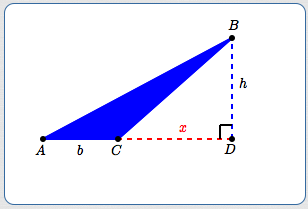
Let $\,x\,$ denote the length of the red-dashed segment.
Then:
$$ \begin{align} &\cssId{s26}{\text{Area of blue triangle}}\cr\cr &\quad \cssId{s27}{= \quad \text{Area of big right triangle } (\triangle ABD)}\cr &\qquad\ \ - \text{Area of small right triangle } (\triangle CBD)\cr\cr &\quad \cssId{s28}{= \quad \frac 12(b+x)h - \frac 12 xh}\cr\cr &\quad \cssId{s29}{= \quad \frac 12bh + \frac 12xh - \frac 12xh}\cr\cr &\quad \cssId{s30}{= \quad \frac 12bh} \end{align} $$
Area of blue triangle is $\,\frac 12 bh$
Note that there are infinitely many triangles with a given base/height pair . For example, all the triangles below have the same base/height pair.
Same base/height pair—same area! A base/height pair uniquely determines the area of a triangle, but not the shape of the triangle.
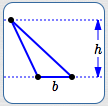
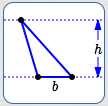
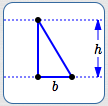
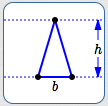
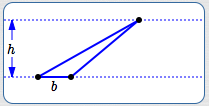
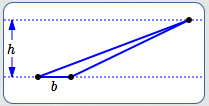
All these triangles have the same base/height pair, hence the same area.
Area of a Triangle Using Two Sides and an Included Angle
By the SAS (side-angle-side) triangle congruence theorem, two sides and an included angle uniquely defines a triangle.
Let $\,a\,$ and $\,b\,$ denote two sides of a triangle, with included angle $\,\theta\,.$
The sketches below show the two situations that can occur when finding the altitude that has corresponding base $\,b\,.$ In both cases, the altitude length is found using the yellow triangle (which is a right triangle with hypotenuse $\,a\,$).
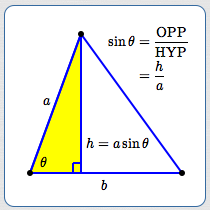
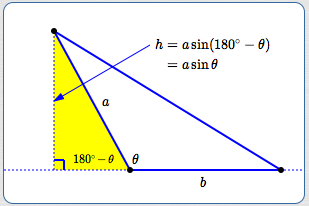
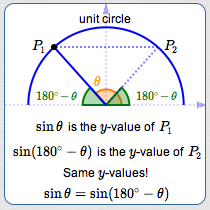
In both cases, the altitude length is $\,h = a\sin\theta\,.$ Thus:
$$ \begin{align} &\cssId{s45}{\Large\substack{\text{Area of triangle}\\ \text{with sides $a$ and $b$}\\ \text{and included angle $\theta$}}}\cr\cr &\qquad\ \ \cssId{s46}{= \frac 12(\text{base})(\text{height})}\cr\cr &\qquad\ \ \cssId{s47}{= \frac 12 b(a\sin\theta)}\cr\cr &\qquad\ \ \cssId{s48}{= \frac 12 ab\sin\theta} \end{align} $$In words, the area is:
Half the product of the two sides, times the sine of the included angle
Note: When we write $\,180^\circ - \theta\,,$ it is assumed that $\,\theta\,$ is measured in degrees.